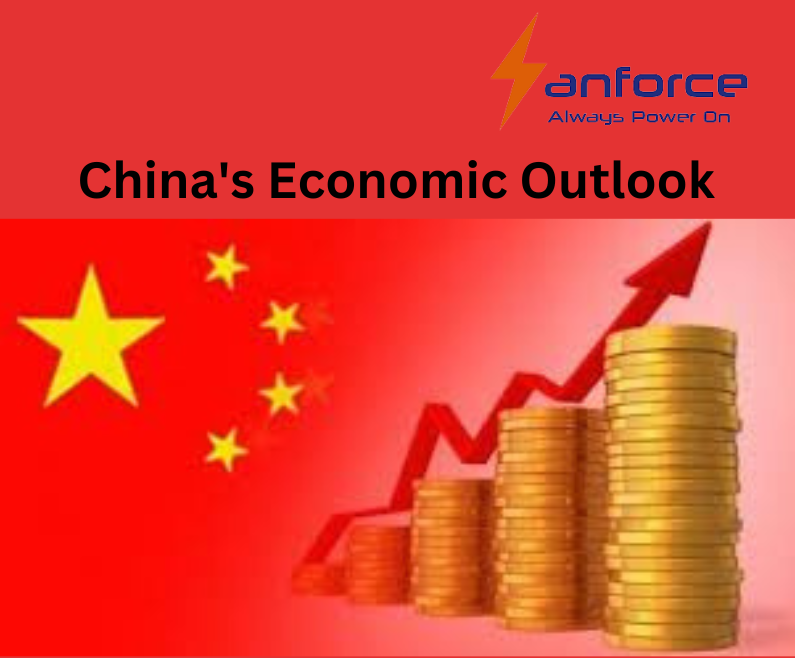China’s position as a global economic powerhouse has a profound impact on the landscape of international trade. To succeed in the global marketplace, businesses must grasp China’s economic outlook and the resulting implications for global trading.
This comprehensive article delves into the current economic trends in China, exploring their influence on global trade. We will examine China’s robust GDP growth, trade policies, and emerging sectors, providing valuable insights for businesses engaged in international trade, including those involved in emergency LED lights.


China’s economy began 2023 on a strong note, witnessing a surge in consumer spending following the lifting of strict pandemic restrictions that lasted for three years. The National Bureau of Statistics reported a notable 4.5% year-on-year growth in gross domestic product during the first quarter.
A. Robust and Resilient Growth
China’s remarkable GDP growth over the past decades, surpassing expectations.
Factors contributing to China’s robust economic performance, including investment, consumption, and innovation.
China’s transition from an export-oriented economy to a consumption-driven economy and its impact on global trade dynamics. The rise of the middle class and its role in driving economic growth and consumer demand.
B. Shifts in Sectoral Composition
The evolving structure of China’s economy and the transformation of traditional industries.
The rise of the service sector and its impact on economic growth, job creation, and domestic consumption.
Opportunities and challenges in the manufacturing sector, including technological advancements and automation. The role of innovation and technology in driving economic transformation and creating new trade opportunities.
A. Trade Liberalization Efforts
China’s commitment to free trade, globalization, and opening up its markets.
Initiatives to attract foreign investment, such as the Foreign Investment Law and the removal of ownership restrictions.
The Belt and Road Initiative and its potential to reshape global trade patterns.
B. Trade Disputes and Tariffs
Escalating trade tensions between China and the United States and their impact on global trade confidence.
Implications of tariff wars on global supply chains and trade flows. The Regional Comprehensive Economic Partnership (RCEP) and its potential effects on China’s trade relationships.
C. Shift towards Regional Trade:
Growing regional trade agreements and partnerships, including the RCEP and China’s engagement in multilateral trade forums.
The impact of regional trade integration on China’s trade dynamics and global trade flows.
China’s role in promoting regional economic integration in Asia and its implications for global trade networks.
A. Technology and Innovation:
China’s rapid technological advancements and the growth of its innovation ecosystem.
The dominance of Chinese tech giants in the global market and their influence on trade patterns.
Opportunities for collaboration, technology transfer, and investment in emerging sectors such as artificial intelligence and 5G.
B. Renewable Energy and Environmental Initiatives:
China’s commitment to renewable energy, sustainability, and green development has paved the way for remarkable growth in the clean energy sector, including solar and wind power, significantly impacting global trading.
This shift towards clean energy presents vast opportunities for businesses in industries related to energy efficiency and environmental protection, such as LED lighting, including emergency lighting products.
C. E-commerce and Digital Economy:
The exponential growth of China’s e-commerce market, driven by a tech-savvy population and digital innovation. Cross-border e-commerce and its impact on global trade, creating new channels and opportunities for businesses.
Opportunities and challenges for businesses in the digital economy, including data security, regulatory compliance, and market competition.
A. Market Opportunities:
B. Supply Chain and Logistics:
Integration into China’s supply chain network and the benefits of proximity to manufacturing hubs. Efficient logistics and distribution strategies to navigate China’s vast geography and transportation infrastructure.
Navigating regulatory requirements, customs procedures, and trade documentation to ensure smooth trade operations.
C. Business Strategies:
Adapting to China’s market dynamics and consumer preferences through market research and localization strategies. Establishing partnerships and networks with Chinese counterparts, leveraging local expertise and relationships.
Harnessing China’s technological advancements and innovation capabilities to enhance global competitiveness.
D. Risk Management:
Understanding and managing the risks associated with operating in China, including regulatory changes and political uncertainties.
Developing contingency plans and diversifying supply chains to mitigate disruptions.
Monitoring and assessing market trends and policy developments to stay ahead of the curve.
As one of the world’s largest manufacturers, China plays a pivotal role in global trade across various industries. In particular, the LED lighting sector in China has witnessed significant growth, offering a diverse range of products and services to meet the evolving needs of customers worldwide.
China’s manufacturing capabilities in the LED lighting industry extend from the production of individual LED emergency modules to comprehensive services for lighting projects. The country’s vast manufacturing infrastructure enables efficient production and delivery of LED emergency modules and emergency lightning battery pack ensuring timely and reliable supply to customers across different regions.
What sets China apart is its ability to cater to individual customer needs and adapt to local conditions. Chinese LED lighting manufacturers understand the importance of customization and offer a wide array of options to tailor their products and services accordingly. Whether it’s specific design requirements, different voltage standards, or compatibility with existing lighting systems, Chinese manufacturers can accommodate diverse customer preferences and project specifications.
China’s economic outlook and its implications for global trading are of utmost importance for businesses operating in the international marketplace. The robust GDP growth, evolving trade policies, and emerging sectors in China create both opportunities and challenges for global trade.
By staying abreast of China’s economic trends, businesses can position themselves strategically to capitalize on market opportunities, navigate regulatory complexities, and forge successful trade partnerships. Embracing China’s economic landscape and its integration into the global trading system is vital for long-term business growth and success in the ever-evolving world of international trade.
Not sure what you required for your lightining project ?
Get in touch with us for FREE consultation.